 |
New York Architecture Images-New York Bridges Hell Gate Bridge |
||||||||||||||||||||||||||||
| Contemporary black and white images on this page copyright Dave Frieder ( www.davefrieder.com ). Special thanks to Dave Frieder for permission to use images. | |||||||||||||||||||||||||||||
|
architect |
Gustav Lindenthal, Othmar Ammann | ||||||||||||||||||||||||||||
|
location |
The Hell Gate Bridge connects Wards Island to Astoria Queens. | ||||||||||||||||||||||||||||
|
date |
1916 | ||||||||||||||||||||||||||||
|
style |
Structural Expressionism, Beaux-Arts | ||||||||||||||||||||||||||||
|
construction |
Steel | ||||||||||||||||||||||||||||
|
type |
Steel arch Bridge | ||||||||||||||||||||||||||||
|
data |
|
||||||||||||||||||||||||||||
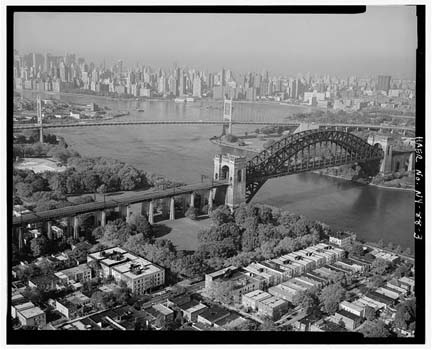
|
|||||||||||||||||||||||||||||
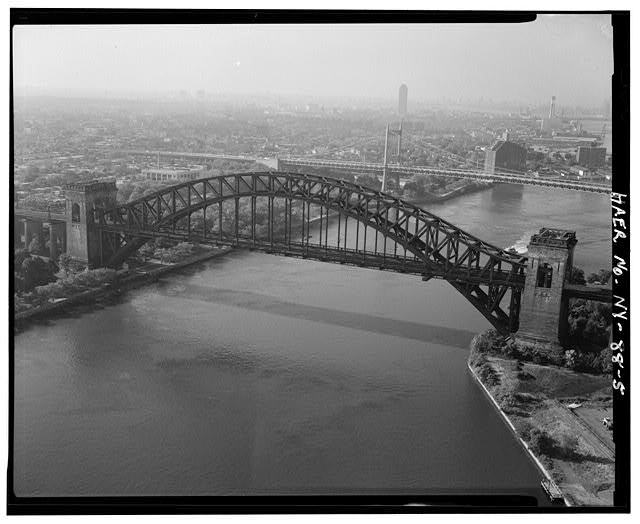
|
|||||||||||||||||||||||||||||
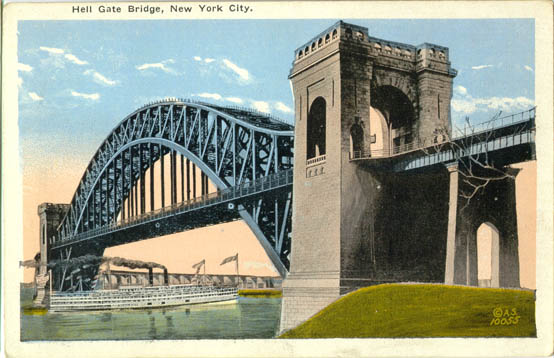 |
|||||||||||||||||||||||||||||
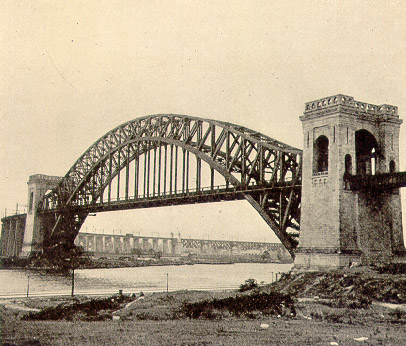 |
|||||||||||||||||||||||||||||
 |
|||||||||||||||||||||||||||||
|
|
      |
||||||||||||||||||||||||||||
|
images |
       |
||||||||||||||||||||||||||||
| Dave Frieder Gallery. Copyright Dave Frieder ( www.davefrieder.com ) | |||||||||||||||||||||||||||||
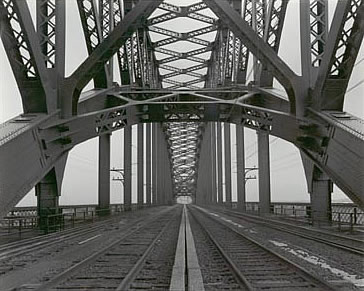 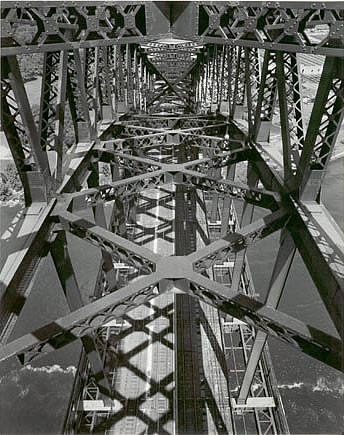 |
|||||||||||||||||||||||||||||
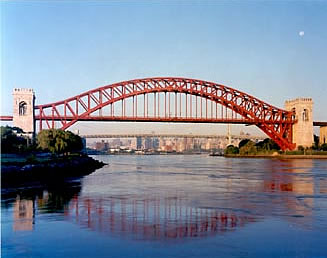 |
|||||||||||||||||||||||||||||
|
The Hell Gate Bridge (originally the New York Connecting Railroad Bridge
or The East River Arch Bridge) is a 1,017-foot (310 m) steel arch
railroad bridge between Astoria in the borough of Queens and Randalls
and Wards Islands (which are now joined into one island and are
politically part of Manhattan) in New York City, over a portion of the
East River known as Hell Gate. The Bridge is used by Amtrak and by some CSX, Canadian Pacific, Providence & Worcester Railroad, and New York and Atlantic freight trains. The bridge and structure are owned by Amtrak, part of its Washington, D.C. to Boston electrified main line known as the Northeast Corridor. Metro-North Railroad trains may one day run on the bridge. The bridge is also part of the New York Connecting Railroad, a rail line that links New York City and Long Island to the North American mainland. The Hell Gate Bridge runs parallel to the Queens span of the Triborough Bridge, which connects Queens, the Bronx, and Manhattan, and drivers can see the length of the bridge just east of the roadway. The great arch bridge is the largest of three bridges, along with more than 17,000 feet (5.2 km) long of approach spans and viaducts, that form the Hell Gate complex. An inverted bowstring truss bridge with four 300-foot spans crosses the Little Hell Gate (now filled in); and a 350-foot fixed truss bridge crosses the Bronx Kills (also now filled in). History The bridge was conceived in the early 1900s as a way to link New York and the Pennsylvania Railroad with New England and the New Haven Railroad. Construction was overseen by Gustav Lindenthal, whose original design left a gap of 15 feet between the steel arch and the masonry towers. Fearing that the public assumed that the towers were structurally integral to the bridge, Lindenthal added aesthetic girders between the upper chord of the arch and the towers to make the structure appear more robust.[1] The original plans for the piers on the long approach ramps called for a steel lattice structure. The design was changed to smooth concrete to soothe concerns that asylum inmates on Ward's and Randall's islands would climb the piers to escape. [2] The engineering was so precise that when the last section of the main span was lifted into place, the final adjustment needed to join everything together was half an inch. The bridge was completed on September 30, 1916. It was the world's longest steel arch bridge until the Bayonne Bridge was opened in 1932. The bridge originally carried four tracks, two each for passenger and freight, but one freight track was abandoned in the mid-1970s. At one time, all tracks were electrified with the NH-PRR standard 11 kV 25 Hz overhead catenary; the passenger tracks since 1917, and the freight tracks from 1927 to 1969. In 1996, the bridge received a facelift, including its first comprehensive paint job in 80 years. It was painted "Hell Gate Red," a dark, natural red. Trivia Was a target for Nazi demolition experts during World War II as part of Operation Pastorius. Is a centerpiece of the 1991 film Queens Logic. Is prominently featured in the 1973 film Serpico. Was the inspiration for the Sydney Harbour Bridge in Sydney, Australia Would be the last New York City bridge to collapse if humans disappeared, taking a least a millennium to do so, according to the February 2005 issue of Discover magazine. Most other bridges would fall in about 300 years. [3] Was offered in miniature by famous toy train maker Lionel, the toy version being significantly 'abridged' due to the enormous size of the prototype. |
|||||||||||||||||||||||||||||
|
Today, a lesson in shameless grandeur and
simplicity. The University of Houston's College of Engineering presents
this series about the machines that make our civilization run, and the
people whose ingenuity created them.
We call the confluence of the Harlem and the East Rivers in New York City Hell's Gate. Dramatic, I suppose, but why not! A bridge opened over Hell's Gate in 1917. It's an arch of iron girders. The arch thickens at each end. It thins toward the center. You get a feeling of buoyancy looking at it. Othmar Ammann, who designed the bridge, caught Hell for it. This, says writer Christopher Bonanos, was an age of ornament, gravity, solidity, and dignity. Ammann's design was imperfect in some ways. But its simplicity, lightness, and freedom signaled a new era in design. Ammann had finished an engineering degree in Switzerland in 1902 and had come here soon after. Now -- in 1930 -- he was hard at work on two really grand bridges that're sure to carry his name far into the 21st century. One was the Bayonne Bridge -- an expanded version of his Hell's Gate triumph. It's a huge graceful arch of open structural steel. The other was the longest suspension bridge up to that time. It's the George Washington Bridge with its 3500-foot span. The George Washington Bridge also has open structural steel towers. At first they were to've been faced with stone, but the Depression required cost cutbacks. Had Ammann meant all along for that great steel span to stand naked at the north portal of New York City? He never would say. Whatever Ammann's intentions, the outspoken modern architect Le Corbusier called it the most beautiful bridge in the world. Meanwhile, Ammann kept tying New York to land. He built the Bronx-Whitestone Bridge. He built the Throgs Neck Bridge. When Ammann died at 86 he'd just finished his last masterpiece. For the second time he'd given us the world's longest suspension span. The Verrazano Narrows Bridge is a plain study in grace, with a 4300-foot central span. He created a radical new deck design for the Verrazano Bridge to keep it from galloping in the wind. The deck thins toward its edges to guide wind around it. Ammann's work was meticulous. The towers are an inch and a half wider at the top to keep gravity's force dead-vertical -- despite Earth's curvature. So this remarkable 19th-century engineer left his stamp on bridge-building down through the 20th century. He helped shape a new attitude toward design. Ammann was born ten years before the Eiffel tower was built. And he showed us the steel at the heart of design. Writer Bonanos says that he expressed structure without shame. It is that shameless joy in naked function that touches us. It is the simple grandeur of open steel against the sky. John Lienhard The massive beauty and advanced technology of the Hell Gate Bridge (more properly the New York Connecting Railroad Bridge) contrast sharply with nineteenth-century descriptions of the channel that it spans. Named for the dangerous rocks and perilous waters at the confluence of the East and the Harlem Rivers, Hell Gate is surrounded by Manhattan, Queens, and three islands: Wards, Randalls, and Roosevelt (formerly called Blackwell's, then Welfare). Philip Hone (1780 -1851), writing of an 1844 visit there, described "the delightful scene: the clumps of fine old trees clothed in the gorgeous foliage of autumn, the lawn still bright and green, the mild, refreshing breeze, the rapid waters of Hell Gate covered with sailing vessels and steamboats -all combined to present a picture of consummate beauty." The construction of the Pennsylvania Railroad tunnel under the Hudson River and into Pennsylvania Station replaced the time-consuming and expensive water route for New York -bound passengers and freight from New Jersey and points south. Hell Gate Bridge -from the Sunnyside Yards in Queens across the Hell Gate to Wards Island, then across the Little Hell Gate to Randalls Island, and then over the Bronx Kill to the Bronx -was built to complete the linkage of the New York, New England, and Long Island rail lines with the Hudson River crossing. Together, tunnel and bridge created a direct route over the Bronx Kill to the Bronx. The longest, heaviest, strongest steel arch bridge in the world at that time and the only four-track long-span railroad bridge ever built, Hell Gate Bridge marks the apogee of American railroad power and prosperity. Government regulation, poor management, and a proliferation of alternative methods of transportation -private cars, trucks, buses, and airplanes -eventually undercut the railroad's primacy. Engineer Gustave Lindenthal (1850 -1935) and architect Henry Hornbostel (1867 -1961) had previously been responsible for the redesign of both the Manhattan and Queensboro Bridges. Lindenthal, who served in 1902 -1903 as Commissioner of Bridges, firmly believed that a bridge could be both technologically sound and aesthetically pleasing. Despite his accomplishments and success, Lindenthal probably had no formal training in his chosen profession but apparently possessed "the extraordinary intelligence, energy, and self-discipline that enabled him to teach himself mathematics, engineering theory, metallurgy, hydraulics, estimating, management, and everything else a successful bridge designer had to know."
PROVIDING A MUCH-NEEDED RAILROAD CONNECTION: In
1892, Oliver W. Barnes, an engineer associated with Pennsylvania
Railroad president Alexander J. Cassatt and bridge designer Gustav
Lindenthal, conceived plans for the Hell Gate Bridge. Cassatt saw the
Hell Gate project - originally called the "East River Arch Bridge" - as
an opportunity to bring rail traffic from Pennsylvania Railroad routes
in New Jersey and points west through New York City to New England. The
project was to also tie into the Long Island Rail Road routes, in which
the Pennsylvania Railroad had a controlling interest. Meanwhile,
Lindenthal saw the Hell Gate project as his chance to construct his
Hudson River Bridge, a suspension bridge with a 2,800-foot-long main
span that would have been the longest in the world. That same year, the
New York Connecting Railroad was incorporated to help realize this plan.
CONSTRUCTING THE HELL
GATE COMPLEX: Lindenthal employed a staff of 95
engineers to calculate how the weight of the trains would be borne by
various parts of the bridge, how individual steel members would be made
and joined, how much masonry would be required, and how the different
functions of bridge construction (for example, the location of bridge
abutments vis-à-vis the alignment of the steelwork) would be
coordinated. With other engineers performing the calculations,
Lindenthal concentrated on the aesthetics of the bridge.
|
|||||||||||||||||||||||||||||